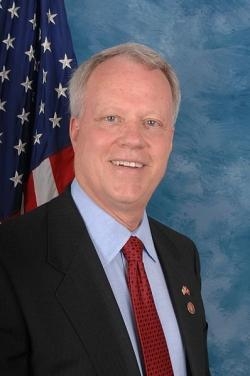Thu, Feb 21, 2013
Science Subcommittee On Oversight Considers Threats To Control, Jamming, GPS Spoofing
The House Science Committee Subcommittee on Oversight has held its first hearing of the 113th Congress, examining challenges and federal research and development (R&D) efforts to integrate Unmanned Aircraft Systems (UAS) safely into the National Airspace System (NAS).

“Aviation has come a long way in a relatively short time thanks to American innovation and ingenuity. Just as UAS have sparked a revolution in military affairs, they will likely also transform civilian and commercial sectors," said Subcommittee Chairman Paul Broun, M.D. (R-GA) (pictured). “The threat of command and control link jamming, GPS navigation signal spoofing, and system hacking is a real concern that will have to be addressed before any UAS integration into the NAS. Overcoming these challenges will require significant R&D investments by both the public and private sector. Given our nation’s current financial state, this demands more efficient coordination between all stakeholders.”
The UAS market is dynamic and the civilian and commercial sectors are poised for explosive growth. Last year, Congress passed the FAA Modernization and Reform Act, which directed that federal agencies accelerate the integration of UAS into the national airspace. As the lead agency, FAA is responsible for ensuring that the integration of UAS does not degrade the safety and efficiency of the NAS.
According to recent press reports, at least nine American UAS crashes occurred near civilian airports overseas as a result of pilot error, mechanical failure, software bugs or poor coordination with air traffic controllers. Further, in August of 2010, a Navy UAS reportedly violated airspace over Washington, D.C. when operators lost contact due to a “software issue.”
Witnesses at the hearing discussed significant achievements, missed milestones and ongoing efforts to safely integrate UAS. They also indicated that continued close collaboration among all UAS stakeholders will be critical to minimizing duplication of research and addressing remaining obstacles.
More News
From 2023 (YouTube Version): Legacy of a Titan Robert (Bob) Anderson Hoover was a fighter pilot, test pilot, flight instructor, and air show superstar. More so, Bob Hoover was an i>[...]
Get The Latest in Aviation News NOW on Instagram Are you on Instagram yet? It's been around for a few years, quietly picking up traction mostly thanks to everybody's new obsession >[...]
Aero Linx: B-52H Stratofortress The B-52H Stratofortress is a long-range, heavy bomber that can perform a variety of missions. The bomber is capable of flying at high subsonic spee>[...]
Altimeter Setting The barometric pressure reading used to adjust a pressure altimeter for variations in existing atmospheric pressure or to the standard altimeter setting (29.92).>[...]
"Knowing that we play an active part in bettering people's lives is extremely rewarding. My team and I are very thankful for the opportunity to be here and to help in any way we ca>[...]
 Classic Aero-TV: Remembering Bob Hoover
Classic Aero-TV: Remembering Bob Hoover ANN FAQ: Follow Us On Instagram!
ANN FAQ: Follow Us On Instagram! ANN's Daily Aero-Linx (05.15.24)
ANN's Daily Aero-Linx (05.15.24) ANN's Daily Aero-Term (05.15.24):Altimeter Setting
ANN's Daily Aero-Term (05.15.24):Altimeter Setting Aero-News: Quote of the Day (05.16.24)
Aero-News: Quote of the Day (05.16.24)



